tow SKODA FABIA 2004 1.G / 6Y Repair Manual
[x] Cancel search | Manufacturer: SKODA, Model Year: 2004, Model line: FABIA, Model: SKODA FABIA 2004 1.G / 6YPages: 247
Page 219 of 247
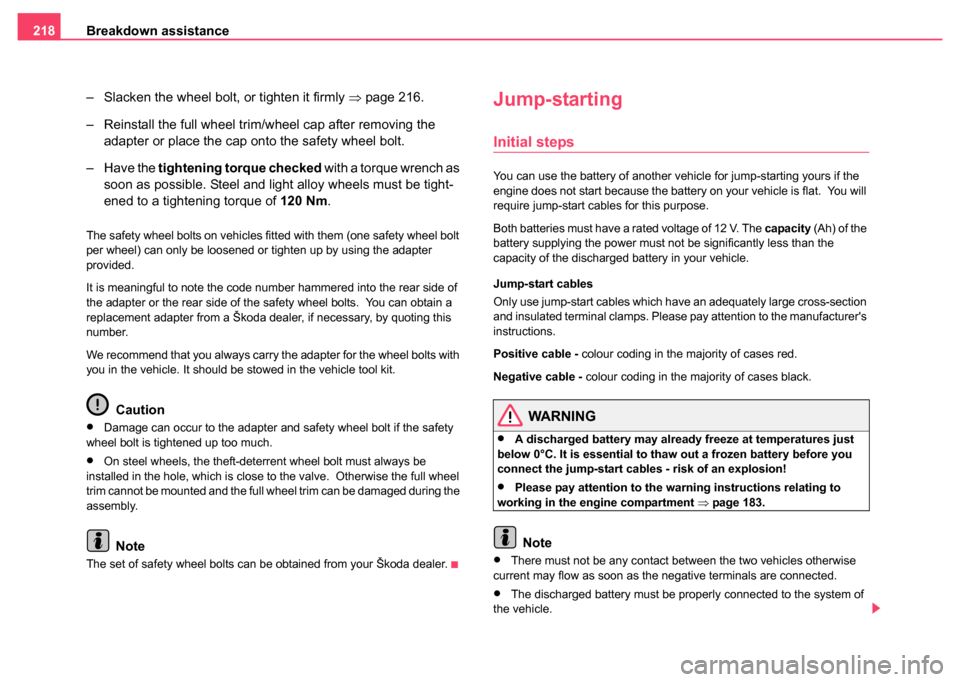
Breakdown assistance
218
– Slacken the wheel bolt, or tighten it firmly ⇒page 216.
– Reinstall the full wheel trim/wheel cap after removing the adapter or place the cap onto the safety wheel bolt.
– Have the tightening torque checked with a torque wrench as
soon as possible. Steel and light alloy wheels must be tight-
ened to a tightening torque of 120 Nm.
The safety wheel bolts on vehicles fitted with them (one safety wheel bolt
per wheel) can only be loosened or tighten up by using the adapter
provided.
It is meaningful to note the code number hammered into the rear side of
the adapter or the rear side of the safety wheel bolts. You can obtain a
replacement adapter from a Škoda dealer, if necessary, by quoting this
number.
We recommend that you always carry the adapter for the wheel bolts with
you in the vehicle. It should be stowed in the vehicle tool kit.
Caution
•Damage can occur to the adapter and safety wheel bolt if the safety
wheel bolt is tightened up too much.
•On steel wheels, the theft-deterrent wheel bolt must always be
installed in the hole, which is close to the valve. Otherwise the full wheel
trim cannot be mounted and the full wheel trim can be damaged during the
assembly.
Note
The set of safety wheel bolts can be obtained from your Škoda dealer.
Jump-starting
Initial steps
You can use the battery of another vehicle for jump-starting yours if the
engine does not start because the battery on your vehicle is flat. You will
require jump-start cables for this purpose.
Both batteries must have a rated voltage of 12 V. The capacity (Ah) of the
battery supplying the power must not be significantly less than the
capacity of the discharged battery in your vehicle.
Jump-start cables
Only use jump-start cables which have an adequately large cross-section
and insulated terminal clamps. Please pay attention to the manufacturer's
instructions.
Positive cable - colour coding in the majority of cases red.
Negative cable - colour coding in the majority of cases black.
WARNING
•A discharged battery may already freeze at temperatures just
below 0°C. It is essential to thaw out a frozen battery before you
connect the jump-start cables - risk of an explosion!
•Please pay attention to the warning instructions relating to
working in the engine compartment ⇒page 183.
Note
•There must not be any contact between the two vehicles otherwise
current may flow as soon as the negative terminals are connected.
•The discharged battery must be properly connected to the system of
the vehicle.
Page 221 of 247
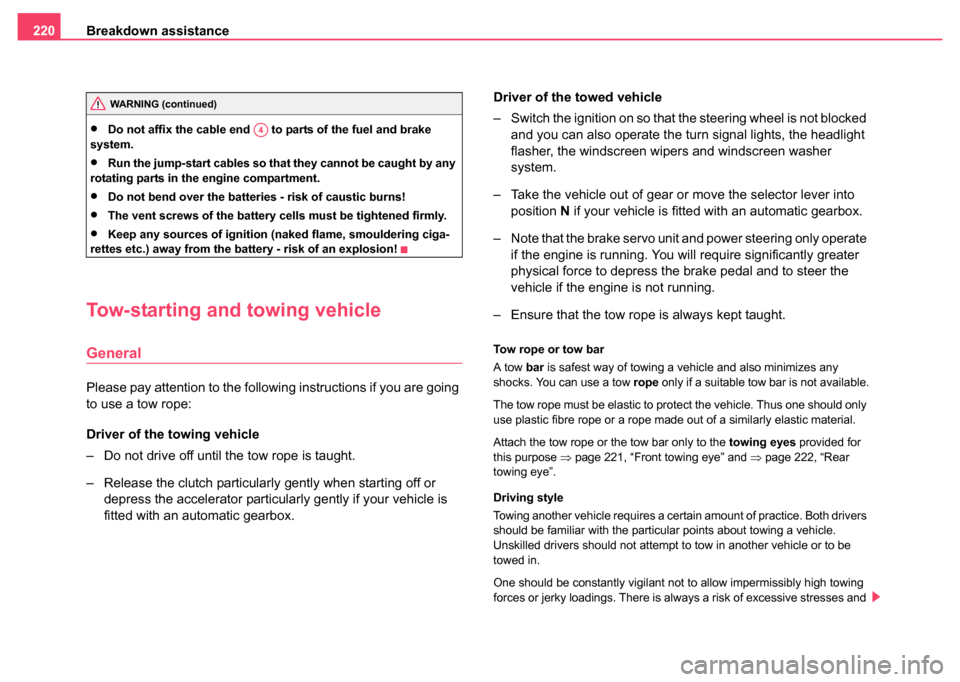
Breakdown assistance
220
•Do not affix the cable end to parts of the fuel and brake
system.
•Run the jump-start cables so that they cannot be caught by any
rotating parts in the engine compartment.
•Do not bend over the batteries - risk of caustic burns!
•The vent screws of the battery cells must be tightened firmly.
•Keep any sources of ignition (naked flame, smouldering ciga-
rettes etc.) away from the battery - risk of an explosion!
Tow-starting and towing vehicle
General
Please pay attention to the following instructions if you are going
to use a tow rope:
Driver of the towing vehicle
– Do not drive off until the tow rope is taught.
– Release the clutch particularly gently when starting off or depress the accelerator particularly gently if your vehicle is
fitted with an automatic gearbox. Driver of the towed vehicle
– Switch the ignition on so that the steering wheel is not blocked
and you can also operate the turn signal lights, the headlight
flasher, the windscreen wipers and windscreen washer
system.
– Take the vehicle out of gear or move the selector lever into position N if your vehicle is fitted with an automatic gearbox.
– Note that the brake servo unit and power steering only operate if the engine is running. You will require significantly greater
physical force to depress the brake pedal and to steer the
vehicle if the engine is not running.
– Ensure that the tow rope is always kept taught.
Tow rope or tow bar
A tow bar is safest way of towing a vehicle and also minimizes any
shocks. You can use a tow rope only if a suitable tow bar is not available.
The tow rope must be elastic to protect the vehicle. Thus one should only
use plastic fibre rope or a rope made out of a similarly elastic material.
Attach the tow rope or the tow bar only to the towing eyes provided for
this purpose ⇒ page 221, “Front towing eye” and ⇒page 222, “Rear
towing eye”.
Driving style
Towing another vehicle requires a certain amount of practice. Both drivers
should be familiar with the particular points about towing a vehicle.
Unskilled drivers should not attempt to tow in another vehicle or to be
towed in.
One should be constantly vigilant not to allow impermissibly high towing
forces or jerky loadings. There is always a risk of excessive stresses and
WARNING (continued)
A4
Page 222 of 247

Breakdown assistance221
Using the systemSafetyDriving TipsGeneral MaintenanceBreakdown assistanceTechnical Data
damage resulting at the points to which you attach the tow rope or tow bar
when you attempt to tow a vehicle which is not standing on a paved road.
Caution
If the gearbox of your vehicle no longer contains any oil because of a
defect, your vehicle must only be towed in with the driven wheels raised
clear of the ground, or on a special vehicle transporter or trailer.
Note
•Please comply with any legal requirements particularly regarding the
switched on signal systems, when towing in or tow-starting another
vehicle.
•The tow rope must not be twisted as it may in certain circumstances
result in the front towing eye being unscrewed out of your vehicle.
Front towing eye
The towing eye is stored in the box for the vehicle tool kit.
Remove the protective grille carefully as follows:
Fig. 160 Front
bumper: Protective
grille
Fig. 161 Front
bumper: Installing the
towing eye
Page 223 of 247
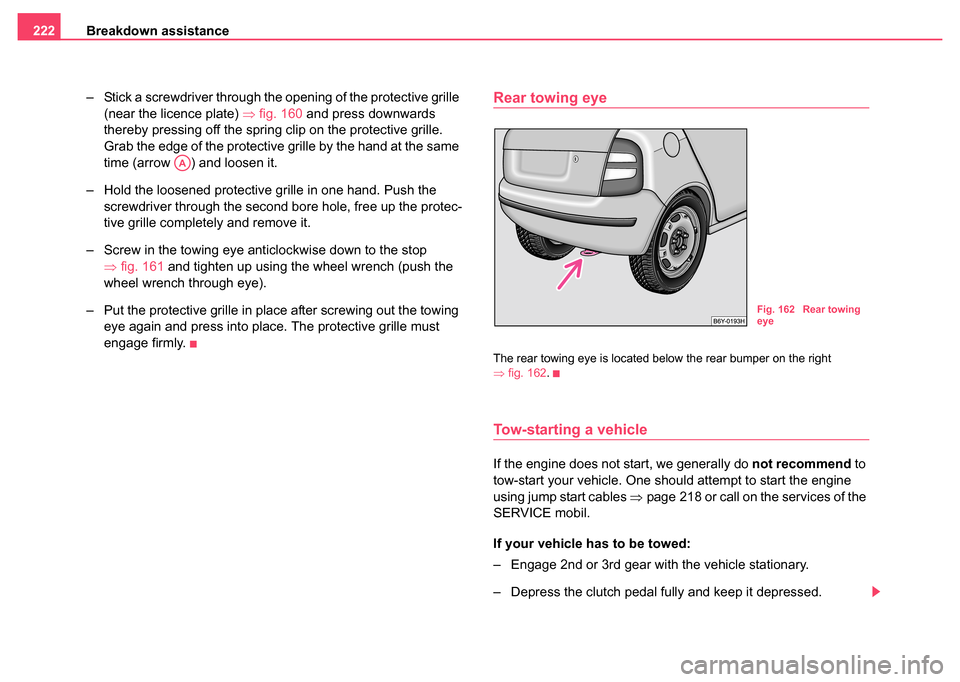
Breakdown assistance
222
– Stick a screwdriver through the opening of the protective grille (near the licence plate) ⇒fig. 160 and press downwards
thereby pressing off the spring clip on the protective grille.
Grab the edge of the protective grille by the hand at the same
time (arrow ) and loosen it.
– Hold the loosened protective grille in one hand. Push the screwdriver through the second bore hole, free up the protec-
tive grille completely and remove it.
– Screw in the towing eye anticlockwise down to the stop ⇒fig. 161 and tighten up using the wheel wrench (push the
wheel wrench through eye).
– Put the protective grille in place after screwing out the towing eye again and press into place. The protective grille must
engage firmly.
Rear towing eye
The rear towing eye is located below the rear bumper on the right
⇒fig. 162 .
Tow-starting a vehicle
If the engine does not start, we generally do not recommend to
tow-start your vehicle. One should attempt to start the engine
using jump start cables ⇒page 218 or call on the services of the
SERVICE mobil.
If your vehicle has to be towed:
– Engage 2nd or 3rd gear with the vehicle stationary.
– Depress the clutch pedal fully and keep it depressed.
AA
Fig. 162 Rear towing
eye
Page 224 of 247
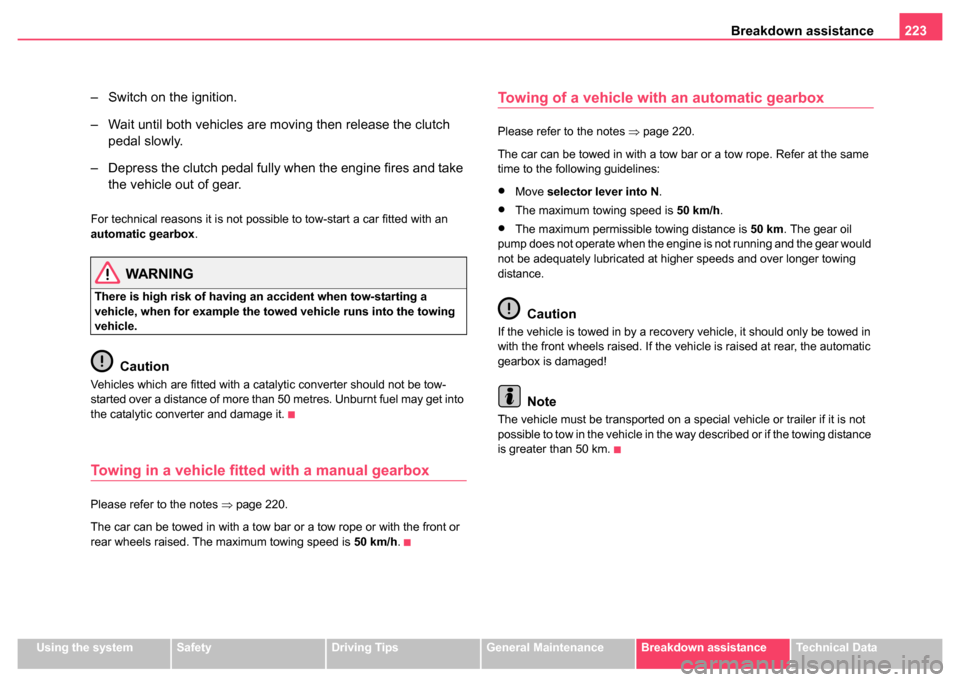
Breakdown assistance223
Using the systemSafetyDriving TipsGeneral MaintenanceBreakdown assistanceTechnical Data
– Switch on the ignition.
– Wait until both vehicles are moving then release the clutch
pedal slowly.
– Depress the clutch pedal fully when the engine fires and take the vehicle out of gear.
For technical reasons it is not possible to tow-start a car fitted with an
automatic gearbox .
WARNING
There is high risk of having an accident when tow-starting a
vehicle, when for example the towe d vehicle runs into the towing
vehicle.
Caution
Vehicles which are fitted with a catalytic converter should not be tow-
started over a distance of more than 50 metres. Unburnt fuel may get into
the catalytic converter and damage it.
Towing in a vehicle fitted with a manual gearbox
Please refer to the notes ⇒page 220.
The car can be towed in with a tow bar or a tow rope or with the front or
rear wheels raised. The maximum towing speed is 50 km/h.
Towing of a vehicle with an automatic gearbox
Please refer to the notes ⇒page 220.
The car can be towed in with a tow bar or a tow rope. Refer at the same
time to the following guidelines:
•Move selector lever into N .
•The maximum towing speed is 50 km/h.
•The maximum permissible towing distance is 50 km. The gear oil
pump does not operate when the engine is not running and the gear would
not be adequately lubricated at higher speeds and over longer towing
distance.
Caution
If the vehicle is towed in by a recovery vehicle, it should only be towed in
with the front wheels raised. If the vehicle is raised at rear, the automatic
gearbox is damaged!
Note
The vehicle must be transported on a special vehicle or trailer if it is not
possible to tow in the vehicle in the way described or if the towing distance
is greater than 50 km.
Page 228 of 247
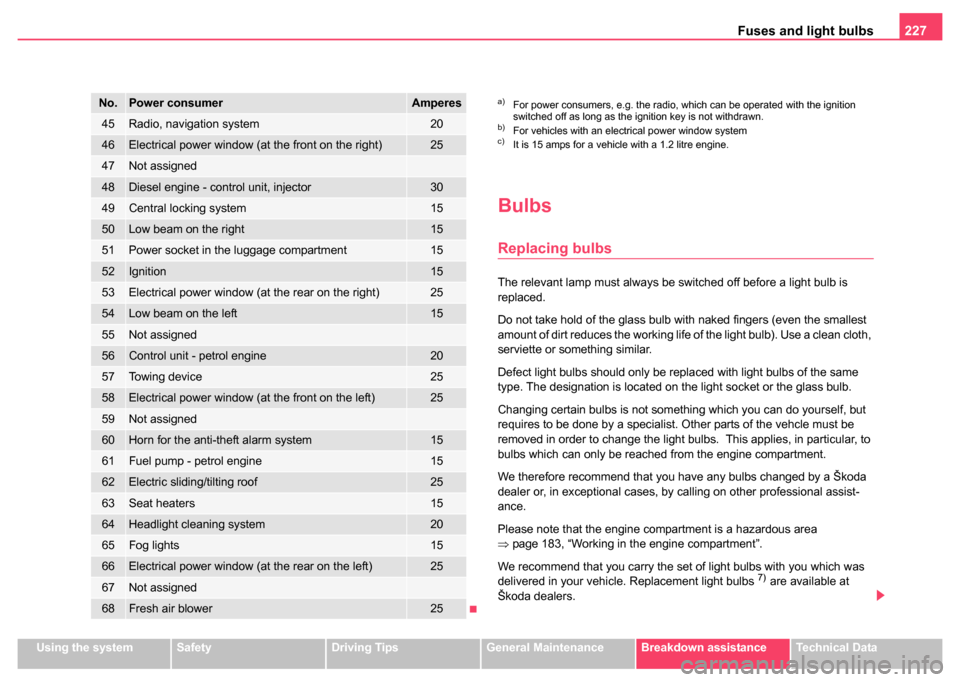
Fuses and light bulbs227
Using the systemSafetyDriving TipsGeneral MaintenanceBreakdown assistanceTechnical Data
Bulbs
Replacing bulbs
The relevant lamp must always be switched off before a light bulb is
replaced.
Do not take hold of the glass bulb with naked fingers (even the smallest
amount of dirt reduces the working life of the light bulb). Use a clean cloth,
serviette or something similar.
Defect light bulbs should only be replaced with light bulbs of the same
type. The designation is located on the light socket or the glass bulb.
Changing certain bulbs is not something which you can do yourself, but
requires to be done by a specialist. Other parts of the vehcle must be
removed in order to change the light bulbs. This applies, in particular, to
bulbs which can only be reached from the engine compartment.
We therefore recommend that you have any bulbs changed by a Škoda
dealer or, in exceptional cases, by calling on other professional assist-
ance.
Please note that the engine compartment is a hazardous area
⇒page 183, “Working in the engine compartment”.
We recommend that you carry the set of light bulbs with you which was
delivered in your vehicle. Replacement light bulbs
7) are available at
Škoda dealers.
45Radio, navigation system20
46Electrical power window (at the front on the right)25
47Not assigned
48Diesel engine - control unit, injector30
49Central locking system15
50Low beam on the right15
51Power socket in the luggage compartment15
52Ignition15
53Electrical power window (at the rear on the right)25
54Low beam on the left15
55Not assigned
56Control unit - petrol engine20
57Towing device25
58Electrical power window (at the front on the left)25
59Not assigned
60Horn for the anti-theft alarm system15
61Fuel pump - petrol engine15
62Electric sliding/tilting roof25
63Seat heaters15
64Headlight cleaning system20
65Fog lights15
66Electrical power window (at the rear on the left)25
67Not assigned
68Fresh air blower25
No.Power consumerAmperesa)For power consumers, e.g. the radio, which can be operated with the ignition
switched off as long as the ignition key is not withdrawn.
b)For vehicles with an electrical power window systemc)It is 15 amps for a vehicle with a 1.2 litre engine.
Page 229 of 247
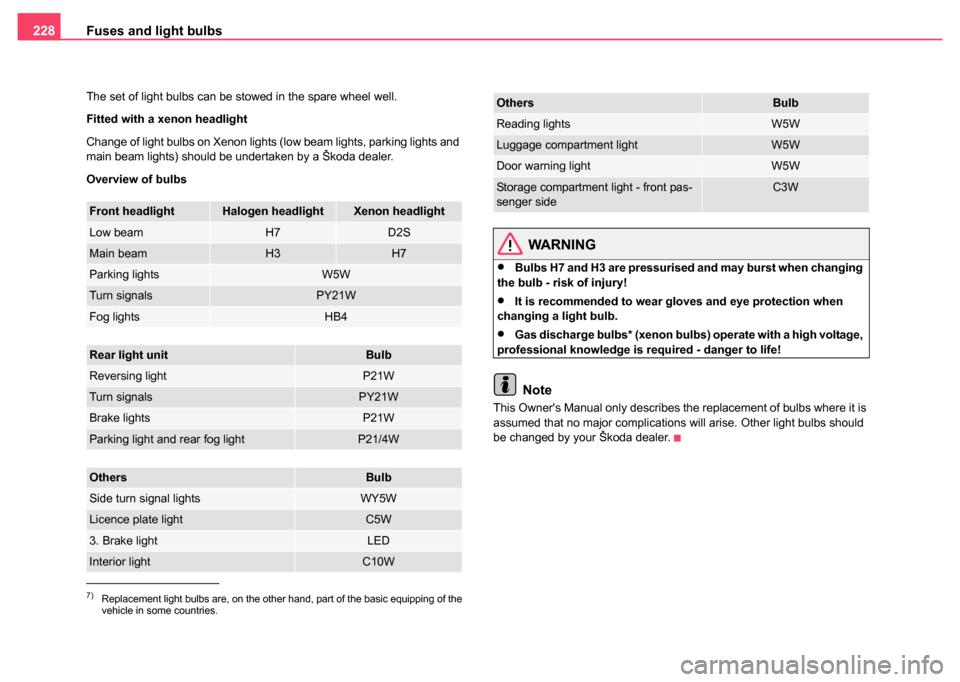
Fuses and light bulbs
228
The set of light bulbs can be stowed in the spare wheel well.
Fitted with a xenon headlight
Change of light bulbs on Xenon lights (low beam lights, parking lights and
main beam lights) should be undertaken by a Škoda dealer.
Overview of bulbs
WARNING
•Bulbs H7 and H3 are pressurised and may burst when changing
the bulb - risk of injury!
•It is recommended to wear gloves and eye protection when
changing a light bulb.
•Gas discharge bulbs* (xenon bulbs) operate with a high voltage,
professional knowledge is required - danger to life!
Note
This Owner's Manual only describes the replacement of bulbs where it is
assumed that no major complications will arise. Other light bulbs should
be changed by your Škoda dealer.
7)Replacement light bulbs are, on the other hand, part of the basic equipping of the
vehicle in some countries.
Front headlightHalogen headlightXenon headlight
Low beamH7D2S
Main beamH3H7
Parking lightsW5W
Turn signalsPY21W
Fog lightsHB4
Rear light unitBulb
Reversing lightP21W
Turn signalsPY21W
Brake lightsP21W
Parking light and rear fog lightP21/4W
OthersBulb
Side turn signal lightsWY5W
Licence plate lightC5W
3. Brake lightLED
Interior lightC10W
Reading lightsW5W
Luggage compartment lightW5W
Door warning lightW5W
Storage compartment light - front pas-
senger sideC3W
OthersBulb
Page 241 of 247
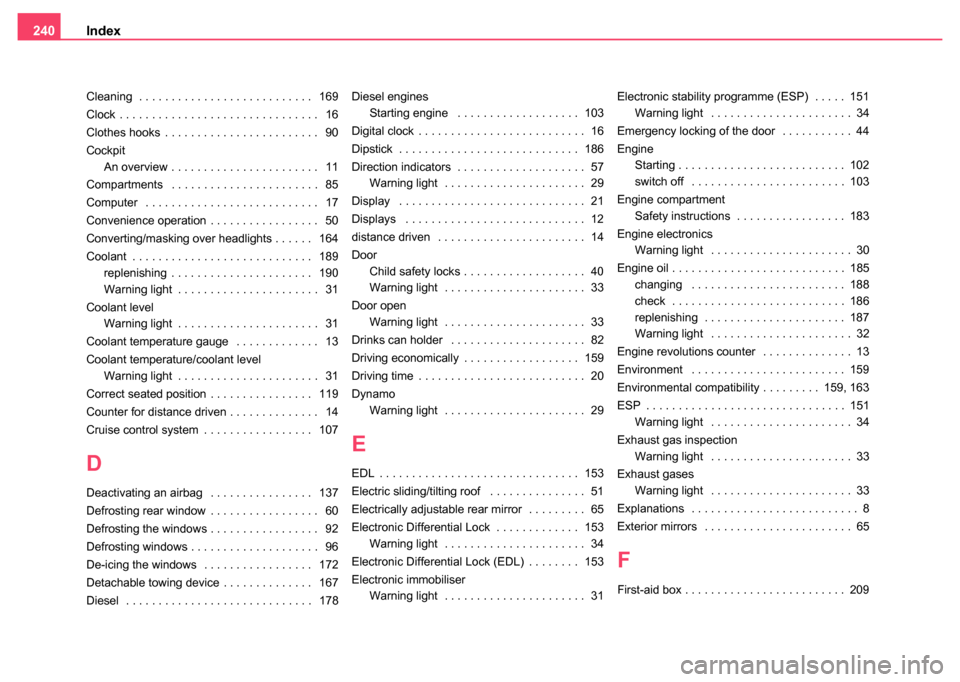
Index
240
Cleaning . . . . . . . . . . . . . . . . . . . . . . . . . . . 169
Clock . . . . . . . . . . . . . . . . . . . . . . . . . . . . . . . 16
Clothes hooks . . . . . . . . . . . . . . . . . . . . . . . . 90
Cockpit
An overview . . . . . . . . . . . . . . . . . . . . . . . 11
Compartments . . . . . . . . . . . . . . . . . . . . . . . 85
Computer . . . . . . . . . . . . . . . . . . . . . . . . . . . 17
Convenience operation . . . . . . . . . . . . . . . . . 50
Converting/masking over headlights . . . . . . 164
Coolant . . . . . . . . . . . . . . . . . . . . . . . . . . . . 189 replenishing . . . . . . . . . . . . . . . . . . . . . . 190
Warning light . . . . . . . . . . . . . . . . . . . . . . 31
Coolant level Warning light . . . . . . . . . . . . . . . . . . . . . . 31
Coolant temperature gauge . . . . . . . . . . . . . 13
Coolant temperature/coolant level Warning light . . . . . . . . . . . . . . . . . . . . . . 31
Correct seated position . . . . . . . . . . . . . . . . 119
Counter for distance driven . . . . . . . . . . . . . . 14
Cruise control system . . . . . . . . . . . . . . . . . 107
D
Deactivating an airbag . . . . . . . . . . . . . . . . 137
Defrosting rear window . . . . . . . . . . . . . . . . . 60
Defrosting the windows . . . . . . . . . . . . . . . . . 92
Defrosting windows . . . . . . . . . . . . . . . . . . . . 96
De-icing the windows . . . . . . . . . . . . . . . . . 172
Detachable towing device . . . . . . . . . . . . . . 167
Diesel . . . . . . . . . . . . . . . . . . . . . . . . . . . . . 178 Diesel engines
Starting engine . . . . . . . . . . . . . . . . . . . 103
Digital clock . . . . . . . . . . . . . . . . . . . . . . . . . . 16
Dipstick . . . . . . . . . . . . . . . . . . . . . . . . . . . . 186
Direction indicators . . . . . . . . . . . . . . . . . . . . 57 Warning light . . . . . . . . . . . . . . . . . . . . . . 29
Display . . . . . . . . . . . . . . . . . . . . . . . . . . . . . 21
Displays . . . . . . . . . . . . . . . . . . . . . . . . . . . . 12
distance driven . . . . . . . . . . . . . . . . . . . . . . . 14
Door Child safety locks . . . . . . . . . . . . . . . . . . . 40
Warning light . . . . . . . . . . . . . . . . . . . . . . 33
Door open Warning light . . . . . . . . . . . . . . . . . . . . . . 33
Drinks can holder . . . . . . . . . . . . . . . . . . . . . 82
Driving economically . . . . . . . . . . . . . . . . . . 159
Driving time . . . . . . . . . . . . . . . . . . . . . . . . . . 20
Dynamo Warning light . . . . . . . . . . . . . . . . . . . . . . 29
E
EDL . . . . . . . . . . . . . . . . . . . . . . . . . . . . . . . 153
Electric sliding/tilting roof . . . . . . . . . . . . . . . 51
Electrically adjustable rear mirror . . . . . . . . . 65
Electronic Differential Lock . . . . . . . . . . . . . 153Warning light . . . . . . . . . . . . . . . . . . . . . . 34
Electronic Differential Lock (EDL) . . . . . . . . 153
Electronic immobiliser Warning light . . . . . . . . . . . . . . . . . . . . . . 31 Electronic stability programme (ESP) . . . . . 151
Warning light . . . . . . . . . . . . . . . . . . . . . . 34
Emergency locking of the door . . . . . . . . . . . 44
Engine Starting . . . . . . . . . . . . . . . . . . . . . . . . . . 102
switch off . . . . . . . . . . . . . . . . . . . . . . . . 103
Engine compartment Safety instructions . . . . . . . . . . . . . . . . . 183
Engine electronics Warning light . . . . . . . . . . . . . . . . . . . . . . 30
Engine oil . . . . . . . . . . . . . . . . . . . . . . . . . . . 185 changing . . . . . . . . . . . . . . . . . . . . . . . . 188
check . . . . . . . . . . . . . . . . . . . . . . . . . . . 186
replenishing . . . . . . . . . . . . . . . . . . . . . . 187
Warning light . . . . . . . . . . . . . . . . . . . . . . 32
Engine revolutions counter . . . . . . . . . . . . . . 13
Environment . . . . . . . . . . . . . . . . . . . . . . . . 159
Environmental compatibility . . . . . . . . . 159, 163
ESP . . . . . . . . . . . . . . . . . . . . . . . . . . . . . . . 151 Warning light . . . . . . . . . . . . . . . . . . . . . . 34
Exhaust gas inspection Warning light . . . . . . . . . . . . . . . . . . . . . . 33
Exhaust gases Warning light . . . . . . . . . . . . . . . . . . . . . . 33
Explanations . . . . . . . . . . . . . . . . . . . . . . . . . . 8
Exterior mirrors . . . . . . . . . . . . . . . . . . . . . . . 65
F
First-aid box . . . . . . . . . . . . . . . . . . . . . . . . . 209
Page 244 of 247
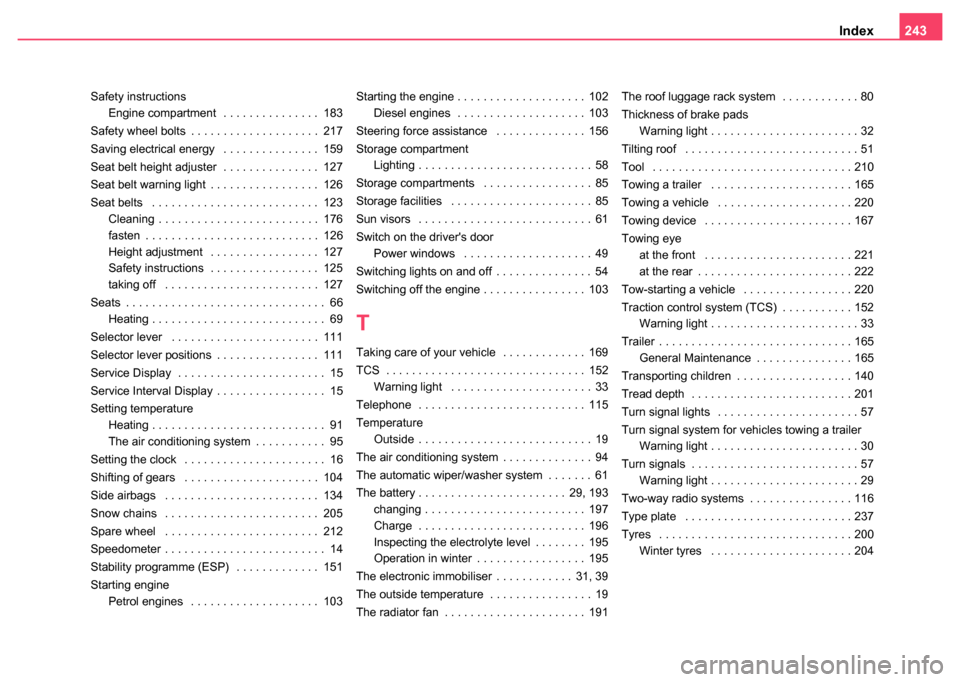
Index243
Safety instructions
Engine compartment . . . . . . . . . . . . . . . 183
Safety wheel bolts . . . . . . . . . . . . . . . . . . . . 217
Saving electrical energy . . . . . . . . . . . . . . . 159
Seat belt height adjuster . . . . . . . . . . . . . . . 127
Seat belt warning light . . . . . . . . . . . . . . . . . 126
Seat belts . . . . . . . . . . . . . . . . . . . . . . . . . . 123 Cleaning . . . . . . . . . . . . . . . . . . . . . . . . . 176
fasten . . . . . . . . . . . . . . . . . . . . . . . . . . . 126
Height adjustment . . . . . . . . . . . . . . . . . 127
Safety instructions . . . . . . . . . . . . . . . . . 125
taking off . . . . . . . . . . . . . . . . . . . . . . . . 127
Seats . . . . . . . . . . . . . . . . . . . . . . . . . . . . . . . 66 Heating . . . . . . . . . . . . . . . . . . . . . . . . . . . 69
Selector lever . . . . . . . . . . . . . . . . . . . . . . . 111
Selector lever positions . . . . . . . . . . . . . . . . 111
Service Display . . . . . . . . . . . . . . . . . . . . . . . 15
Service Interval Display . . . . . . . . . . . . . . . . . 15
Setting temperature Heating . . . . . . . . . . . . . . . . . . . . . . . . . . . 91
The air conditioning system . . . . . . . . . . . 95
Setting the clock . . . . . . . . . . . . . . . . . . . . . . 16
Shifting of gears . . . . . . . . . . . . . . . . . . . . . 104
Side airbags . . . . . . . . . . . . . . . . . . . . . . . . 134
Snow chains . . . . . . . . . . . . . . . . . . . . . . . . 205
Spare wheel . . . . . . . . . . . . . . . . . . . . . . . . 212
Speedometer . . . . . . . . . . . . . . . . . . . . . . . . . 14
Stability programme (ESP) . . . . . . . . . . . . . 151
Starting engine Petrol engines . . . . . . . . . . . . . . . . . . . . 103 Starting the engine . . . . . . . . . . . . . . . . . . . . 102
Diesel engines . . . . . . . . . . . . . . . . . . . . 103
Steering force assistance . . . . . . . . . . . . . . 156
Storage compartment Lighting . . . . . . . . . . . . . . . . . . . . . . . . . . . 58
Storage compartments . . . . . . . . . . . . . . . . . 85
Storage facilities . . . . . . . . . . . . . . . . . . . . . . 85
Sun visors . . . . . . . . . . . . . . . . . . . . . . . . . . . 61
Switch on the driver's door Power windows . . . . . . . . . . . . . . . . . . . . 49
Switching lights on and off . . . . . . . . . . . . . . . 54
Switching off the engine . . . . . . . . . . . . . . . . 103
T
Taking care of your vehicle . . . . . . . . . . . . . 169
TCS . . . . . . . . . . . . . . . . . . . . . . . . . . . . . . . 152 Warning light . . . . . . . . . . . . . . . . . . . . . . 33
Telephone . . . . . . . . . . . . . . . . . . . . . . . . . . 115
Temperature Outside . . . . . . . . . . . . . . . . . . . . . . . . . . . 19
The air conditioning system . . . . . . . . . . . . . . 94
The automatic wiper/washer system . . . . . . . 61
The battery . . . . . . . . . . . . . . . . . . . . . . . 29, 193 changing . . . . . . . . . . . . . . . . . . . . . . . . . 197
Charge . . . . . . . . . . . . . . . . . . . . . . . . . . 196
Inspecting the electrolyte level . . . . . . . . 195
Operation in winter . . . . . . . . . . . . . . . . . 195
The electronic immobiliser . . . . . . . . . . . . 31, 39
The outside temperature . . . . . . . . . . . . . . . . 19
The radiator fan . . . . . . . . . . . . . . . . . . . . . . 191 The roof luggage rack system . . . . . . . . . . . . 80
Thickness of brake pads
Warning light . . . . . . . . . . . . . . . . . . . . . . . 32
Tilting roof . . . . . . . . . . . . . . . . . . . . . . . . . . . 51
Tool . . . . . . . . . . . . . . . . . . . . . . . . . . . . . . . 210
Towing a trailer . . . . . . . . . . . . . . . . . . . . . . 165
Towing a vehicle . . . . . . . . . . . . . . . . . . . . . 220
Towing device . . . . . . . . . . . . . . . . . . . . . . . 167
Towing eye at the front . . . . . . . . . . . . . . . . . . . . . . . 221
at the rear . . . . . . . . . . . . . . . . . . . . . . . . 222
Tow-starting a vehicle . . . . . . . . . . . . . . . . . 220
Traction control system (TCS) . . . . . . . . . . . 152 Warning light . . . . . . . . . . . . . . . . . . . . . . . 33
Trailer . . . . . . . . . . . . . . . . . . . . . . . . . . . . . . 165 General Maintenance . . . . . . . . . . . . . . . 165
Transporting children . . . . . . . . . . . . . . . . . . 140
Tread depth . . . . . . . . . . . . . . . . . . . . . . . . . 201
Turn signal lights . . . . . . . . . . . . . . . . . . . . . . 57
Turn signal system for vehicles towing a trailer Warning light . . . . . . . . . . . . . . . . . . . . . . . 30
Turn signals . . . . . . . . . . . . . . . . . . . . . . . . . . 57 Warning light . . . . . . . . . . . . . . . . . . . . . . . 29
Two-way radio systems . . . . . . . . . . . . . . . . 116
Type plate . . . . . . . . . . . . . . . . . . . . . . . . . . 237
Tyres . . . . . . . . . . . . . . . . . . . . . . . . . . . . . . 200 Winter tyres . . . . . . . . . . . . . . . . . . . . . . 204